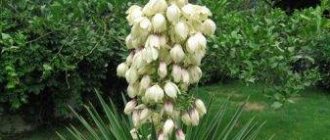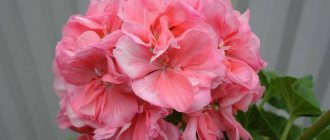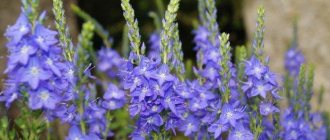Bathwort, fryingweed or trollius is a herbaceous perennial from the Ranunculaceae family. Most often it can be found in the vastness of North America, Asia and Europe. The name of the plant, according to one version, is translated from German as “troll flower”; in another version it is interpreted as “ball”, since the flowers of some varieties resemble it in appearance. The Russian version of the name explains the flower’s tendency to grow in places with high humidity. In addition, the first flowers appear with the opening of the swimming season.
Some sources call the swimsuit the trolls' favorite flower. This statement is based on the legend that during the warm July nights, trolls appear in the fairy forest to prepare a magical drink in bowls of gold. The trolls take the finished potion with them and leave, but leave the golden bowls in which it was brewed. People call these bowls a bathing suit.
What does a swimsuit flower look like?
This plant is also called sparkle in everyday life. This is not surprising, since it is distinguished by spherical flowers of fiery shades. The structure of the flower is very interesting: it consists of a perianth, resembling a corolla, and bright sepals, which can number from five to 20. The stamens of different species may differ in length. The nectaries of this plant are modified petals. The honey pit is located at their base. The sweet aroma of the lights attracts bees.
European swimsuit
The fruits of this plant are leaflets that form a spherical fruit. The seeds are oval in shape and have a shiny black surface.
For your information! This perennial herbaceous plant belongs to the Buttercup family. Only it looks less like garden ranunculus and more like more modest marigolds.
Briefly about the history of appearance
In the wild, lights have been distributed throughout Eurasia since ancient times. Their brief history should begin with the fact that they have been grown in gardens for more than 500 years, mainly for decorative purposes (while in the East, lights are considered medicinal plants). Planting and caring for swimsuits did not require much effort, and this contributed to their popularity. But in those days, mainly the European variety was bred; all the others appeared much later.
Note! The Chinese swimsuit flower first appeared in Europe only 200 years after the domestication of local varieties began. But they were used to breed many modern hybrid varieties.
Why is it called troll flower?
The Latin name for this flower is “Trollius”. Many researchers believe that this name comes from "Trollblume", which translates as "troll flower". Indeed, the swimsuit plant develops well in damp places, where, according to legend, these fairy-tale characters like to settle. In many legends, both Scandinavian and German, this plant is the favorite flower of trolls; supposedly, these creatures brew a healing drink in its spherical flowers.
However, there is another version of this name. Perhaps, given the spherical shape of the flower, the name comes from the Latin word “trulleus”, meaning “round vessel”.
Plant characteristics
In the wild, crop species can grow in a variety of conditions, which influences their characteristics. For example, in Eastern Europe, swimmers grow in forests, as well as in river valleys and near ponds, so they prefer high humidity. In Western Europe and partly in Asia, lights grow in the mountains. These species are relatively drought-resistant. Regardless of whether they grow on the edge of a forest or in the mountains, all these species are very resilient and unpretentious.
Plant conditions
The swimsuit is an unpretentious plant, and it is not difficult to grow it in your garden. To do this, it is enough to choose a suitable place for the culture and moisten it regularly. You will also need to loosen and weed the flower bed and periodically feed the flower.
When growing a swimsuit, do not forget that it is a poisonous plant. So you should wear gloves before manipulating the culture.
Lighting
Swimsuit is a flower (photo, description of the plant is given later in the article) that prefers bright lighting. And for it it is worth choosing open areas located at a distance from tall bushes or trees. In the shade, the shoots of the plant will noticeably stretch out, the buds will become smaller, which will negatively affect its decorative effect.
Temperature
The swimsuit can easily tolerate summer heat above +35 °C. But it is important to keep the soil moist, otherwise the plant will dry out. The culture is frost-resistant and tolerates temperatures down to -20 °C. And some varieties of swimsuit survive winters with frosts down to -35 °C.
But it is advisable to prepare the flower for the cold period. To do this, in mid-autumn you need to trim the bush at the base, leaving shoots 2-3 cm high. Then the plant should be hilled up and sprinkled with fallen leaves or spruce branches. The shelter must be removed as soon as the snow melts. Otherwise, the plant may be banned.
Humidity
The plant is a moisture-loving plant and loves high air humidity. And it is advisable to grow the crop near artificial reservoirs. You should also increase the humidity by regular watering, and spraying the bathing suit, especially during the day, is not recommended. After all, the leaves and buds of the swimsuit do not tolerate moisture when they get wet.
Soil and drainage
The swimsuit prefers light, humus-rich soil, with good air and water permeability with a neutral reaction. If the soil is too heavy, then it should be pre-mixed with sand. And acidic soil must be dug up together with fluff lime and crushed chalk. You can also add wood ash to the soil.
The plant loves when moisture lingers near the roots. So there is no need to arrange drainage in the flowerbed.
Watering
Swimsuit is a flower (photo, description of the culture is given in the material for reference) that needs regular and abundant watering. It is especially important to moisten the soil during dry and hot periods.
But the plant should be watered so that the soil is always moist and not wet, since stagnation of moisture at the roots has a bad effect on the decorative appearance of the plant. With the arrival of autumn, watering must be gradually reduced.
To moisten the soil, you should not use water directly from the well. It is better to place a small container on the site and collect rainwater in it. You can also use ordinary water, but it is advisable to first let it settle and warm up in the sun for 24 hours.
After watering and rainfall, be sure to loosen the soil. Otherwise, a crust will form on it, blocking the access of air to the roots. But in order not to damage the roots of the crop, you need to loosen the soil to a depth of 2-3 cm, no more. During this procedure, it is also worth weeding so that the weeds do not choke the plant.
To make caring for the crop easier, it is advisable to mulch the flowerbed with rotted leaves, straw, peat or pine needles. This layer will prevent the rapid evaporation of moisture, so you will need to water the soil less often. Mulch will also help keep the top layer of soil loose and prevent weeds from growing. So there will be no need for weeding and loosening.
Types of swimsuits and their characteristics
There are many varieties of this plant, which differ even in external characteristics.
Ledebour's swimsuit (Trollius Ledebourii)
Ampelous impatiens - flower, planting and care
This is one of the most interesting species. Ledebur's bathing suit has a rather high peduncle (up to 1 m). Its flowers are large, reaching 6 cm in diameter with bright orange petals. In cultivation, they can be large in size, up to 8 cm. At the same time, the length of nectaries is at least 1.5 cm. In gardening, different varieties are used, which may differ in the coloring of both petals and sepals.
Asian swimmer (Trollius asiaticus)
This species is widespread in landscape design. It is distinguished by bright orange flowers with spread sepals and clearly visible stamens.
For your information! In everyday life, this type is called frying, not swimsuit. There are many varieties of it, including those with double flowers.
Asian swimsuit
In the wild, the height of the peduncle is about 40 cm, but at home it grows more noticeable - up to 70 cm.
European swimsuit (Trollius Europaeus)
This species is also called the common swimsuit. Its description says that its stems can reach 100 cm in height, making it one of the most noticeable varieties. The flowers are large in size and have a pleasant aroma. The color of the petals varies from light yellow to golden. Their stamens are longer than the petals. Blooms in late spring - first half of June.
Note! This plant is becoming increasingly rare in the wild. It is listed in the Red Book of the Republic of Belarus. On the territory of Poland it is also protected by the state.
Trollius Altissimus
The main difference between this species is the height of the peduncle; it is 1.3-1.5 m. Moreover, the plant has quite beautiful openwork leaves. But the flowers of the highest swimsuit are not too bright. They reach a diameter of 6 cm, but are distinguished by a pale greenish-yellow hue.
Dwarf swimsuit (Trollius Pumilus)
As the name suggests, this species is distinguished by its modest size. The rosette of the plant is formed by carved leaves with a jagged edge. From there, around mid-May, straight flower stalks grow, reaching a height of 15-30 cm. But at the same time, their flowers are quite large, at least 2-3 cm in diameter. They are distinguished by the beautiful golden hue of their sepals.
Altai swimsuit (Trollius Altaicus)
This is a fairly tall variety. Its stem grows up to 90 cm in height. Distinguished by slightly open flowers. The sepals have a red tint on the outside. Inside the flower, black pistils and dark red or purple anthers are visible. Flowers appear at the end of May and delight the eye for the whole month.
Cultural swimsuit (Trollius Cultorum)
It differs from other species in that it is a hybrid. Its botanical “ancestors” are plants of four species. These are the Asian, European, Altai and large-petal swimsuits described above. As a result, the leaves of the resulting garden bathing suit have a brighter, juicy green hue. Peduncles grow up to 60-90 cm in height. The flowers are large, their diameter on average is 7 cm.
Important! The color of this hybrid species can be different, including cream, pale yellowish, and orange-red. There are many varieties of it with double flowers.
A special feature of this plant is also that its varieties differ in their flowering time; you can even find those that will bloom until mid-July.
Paper sepal swimsuit (Trollius Chartosepalus)
This species is found in the wild in the northern regions. It is listed in the Red Book. This is a miniature plant, its height is only 15 cm. Its flowers are pale, most often cream-colored. Diameter is about 3 cm.
Half-open swimsuit (Troilius Patulus)
A special feature of this species is its low and practically non-branching stems. They rarely grow to a height of more than 35 cm. Its flowers are medium-sized, up to 30 cm in diameter, and have a golden hue. After flowering ends, the plant stem increases in length.
Lilac swimsuit (Trollius Lilacinus)
While most varieties have yellow or orange flowers, less often cream, this species has a very unusual purple color. But its nectaries are greenish-yellow, like those of other “relatives” growing in the Far East. And in all other respects it looks almost like the Asian variety. Except that the flowers are smaller, maximum 5 cm in diameter.
Lilac swimsuit
Large-petaled swimsuit (Trollius Macropetalus)
This variety has powerful peduncles that can reach a height of 100 cm. But the diameter of the flower is up to 5 cm. The usual colors are yellow and orange. The leaves of this species are large, up to 15 cm wide.
Popular types of trolls' favorite flower
Currently, there are approximately 30 varieties of this cute flower, 20 of them grow in Russia.
European swimsuit
The plant is found in Siberian forests near bodies of water or in the damp lowlands of rivers. Her buds resemble miniature bells. At the beginning of flowering, they look like small lemon balls consisting of glossy sepals. Later they open in all their glory and attract many insects that fly in search of sweet nectar. The base of the plant is decorated with palmately dissected leaves on long petioles.
Chinese swimsuit
The peculiarity of the flower is its large size. It grows up to 120 cm in height and is distinguished by unfolded buds of a wide oval shape. The most famous variety of this species is the Golden Queen swimsuit. Its height is approximately 80 cm. Finger-shaped leaf blades are collected at the base of the plant and remain decorative throughout the season. The golden-colored buds bloom in June and have an unusual shape.
The plant grows successfully in open areas with plenty of sunlight. Loves moisture, but disappears during prolonged stagnation of water. It tolerates winter cold wonderfully and does not need shelter.
The Golden Queen swimsuit shown in the photo is distinguished by its delicate petals, bright color and unique bud shape. It is widely used to decorate artificial ponds, borders, rocky gardens and mixborders.
Swimsuit Dzhungarskaya
This type of flower belongs to short dwarf varieties, reaching a height of only 15 cm. But if the soil is fed with humus, the swimsuit can reach a height of half a meter. In its natural environment it is found in mountains and open areas of mixed forests. It blooms in early summer and lasts a whole month. The buds are painted bright yellow.
Varieties most popular among gardeners
Erythronium pagoda - description of the plant
The most common varieties at the moment are:
- Goliath. This variety is distinguished by very large flowers, reaching a diameter of 7 cm. They attract attention not only in size, but also in the beautiful light orange hue of the nectaries;
- Orange King. Dark orange sepals are the main characteristic of this variety. At the same time, the plant is of medium size;
- Lemon Queen. In full accordance with its name, this variety has lemon-yellow flowers;
- Lightball. The stems of this variety reach a height of 60 cm. The flowers have a beautiful light orange hue;
- Orange Princess. This swimsuit is orange with wide-open flowers and tall stamens;
- Fire Globe. The variety is distinguished by orange nectaries and orange-red sepals, but otherwise looks very similar to Orange Princess;
Lemon queen swimsuit
- Orange Globe. The flowers of this variety are large, bright orange, and the sepals are compact;
- Canary Bird is a variety of yellow cultivar, that is, a hybrid variety with light flowers;
- Alabaster. Another hybrid variety, only this time a variety of the cultivated white swimsuit. It is distinguished by relatively low bushes up to 60 cm in height;
- Elist of All. This is an early variety with bright yellow flowers reaching 7 cm in diameter. But the flower stalks themselves are relatively low, up to 50 cm;
- Goal Cross. This variety looks very unusual: its sepals are yellow and the nectaries are orange, so it looks beautiful, despite the fact that the flowers themselves are quite small;
- Goldquel. A beautiful variety with spectacular and large bright yellow flowers, the diameter of which can reach 6 cm.
Appearance
Bathhouse is a perennial shrub, 50-100 cm high with one or several flowers on a high peduncle. The leaves of the plant are green, cut into five lobes. On one stem there are 10-25 leaves, collected in rosettes. The root system is powerful and goes deep into the ground. Several stems grow from one rhizome.
The swimsuit has gained popularity among flower growers and landscape designers thanks to its large spherical flowers. Their color varies from purple and pale yellow to bright orange.
In some varieties the flower diameter reaches 10 cm, but more often it varies between 3-7 cm. The plant is a honey plant. As you can see in the photo, the outer petals of the corolla are wide, the inner ones are narrow, transformed into nectaries and emit a faint, pleasant smell.
Propagation by seeds
Mock orange snowbel - description, planting and care
To propagate almost all types of swimsuit, it is better to use seeds, although cuttings are theoretically possible, but this is considered a more complicated method.
Important! This plant does not have to be grown from seedlings. It can be sown in open ground. But to ensure high germination, seeds need long-term stratification.
Seed material is collected in July-August, depending on the flowering time of a particular variety.
Boarding time
Most often, seeds are sown in the ground after stratification; this occurs already at the end of October or November.
Mandatory seed stratification
Experienced gardeners mix the seeds collected in August or July with slightly moistened sand, transfer this mixture into a bag and store it in the refrigerator in a box intended for vegetables at a temperature of 2-4 ° C. The seeds must remain there for three months to achieve the desired parameters.
Soil preparation
You need to grow the swimsuit in loose soil with good breathability. Therefore, most often they make a mixture of two parts peat, the same amount of earth and one part sand.
Picking
Shoots begin to appear in the first half of May. If the weather gets hot, they will develop actively, especially if they are provided with abundant watering and protection from the sun. They should be picked after a pair of full leaves appear on the seedlings. The sprouts are planted at a distance of 7-10 cm from each other. As a rule, a year after this, the already strong and expanded plants are planted in a permanent place in the garden.
Is it possible to replant from a pot?
As a rule, this perennial is immediately planted in open ground. But many gardeners plant it in a container for the first year. Then in the second year the question arises of how to plant a bathing suit from a pot. In this case, you need to act carefully so as not to damage the roots.
Important! It is best to carry out the procedure after flowering, when the lights begin their dormant period. This happens in August.
Landing place
Although in nature the crop grows in both sunny and shaded areas, in order to obtain large flowers, in the garden or front garden the plant is placed in the shade on well-moistened but not flooded soil.
Siberian rose prefers medium loamy soil. To better retain moisture in the ground during planting, you can add a mixture of peat and humus at the rate of 5 kg per 1 sq.m. But you need to make sure that the water does not stagnate in the area.
Don't miss: Photos of beautiful varietal peonies
Features of garden care
Growing a swimsuit flower is not particularly difficult even for a novice gardener.
What conditions does the swimsuit like?
Much depends on the climate zone in which this perennial is grown. But in most of Russia, lights prefer weak shading. In open areas, unless the soil is too dry, this perennial does well.
What is the plant afraid of?
During the growth period, the plant is afraid of a lack of moisture, so you need to provide the troll flower with regular watering. In addition, the fire does not like to be transplanted; bushes can grow in one place for at least 10 years. He also has a bad attitude towards digging up the earth around the bush, since the root system grows quickly. These perennials produce a lot of extra stones, and digging can damage them.
Watering
To grow a healthy and beautifully flowering plant, the flame needs to be watered regularly between March and July so that the soil is moist. From August to September, the frequency and intensity of watering is reduced.
Mulching
This technique is optional when growing lights. But it saves the garden owner from weeding at least this area, and also protects the soil from drying out, so you shouldn’t give it up.
Important! The rules are the same as for other plants. Humus or a mixture of sand and peat is added to the bush.
Loosening
The weak point of this plant is that it does not like stagnant groundwater, which is why it requires regular loosening and good drainage of the soil.
Feeding
All varieties of European swimsuit develop well, without requiring special care. However, in order to improve the troll flower’s resistance to adverse environmental factors, experts advise treating it with ash. This is done in early spring. Then, at the beginning of active growth, fertilizing with nitrogen fertilizers will be required. And only then complex fertilizers are used for better flowering.
Transfer
This perennial does not like transplants, and unless absolutely necessary, you should not disturb it. But if the bushes grow too quickly, they are divided into several parts and replanted.
Subtleties of care
In order for the kupavna to bloom profusely, it is important not only to plant it correctly, but also not to forget to care for it:
- Watering. The plant loves moist soil, so it is often watered with warm, settled water, but without overusing it. Young bushes need to be treated especially delicately. In dry summers, mulch and loosening to a depth of 2-4 cm will help retain moisture.
- Feeding. To enhance flowering, until the buds appear, nitroammophoska (5 g per 10 liters of water) or urea (1 tablespoon per bucket of liquid) is introduced every 2-3 weeks. The plant responds well to Agricol. It would not be superfluous to add peat or humus.
- Transfer. Culture does not like this procedure. But among gardeners there is an opinion that when flowering begins, it is better to place the plant in a new place. In order for the kupavna to take root well, it is better to take bushes that are 6-7 years old.
- Wintering. The Siberian rose is cold-resistant, so it does not need to be covered for the winter. Dead leaves are cut off in October, leaving 2-centimeter cuttings. Next year, flower stalks will appear from the bud in the center of the rosette.
- Treatment against diseases and pests. Trollius is rarely susceptible to disease. To protect the crop, it is sprinkled with ash in the spring. The following drugs are used as prevention and treatment: Bordeaux mixture or copper sulfate (for septoria); Lindan, Heterophos (for nematodes); Treasure, Ferazim (from firebrands).
The swimsuit is an unpretentious crop, but its cultivation requires a competent approach and adherence to basic rules of care.
When and how does it bloom
Whether it is white, yellow or orange, this plant blooms very beautifully. However, most varieties have a slight sweetish aroma.
Types of flowers
In cultivation there are varieties with regular or double flowers, consisting of five or 9-10 petals.
Alabaster swimsuit
Flower shapes
The perennial bathing grass has only one flower shape - spherical. But the flowers can be half-open or open.
Flowering period
When the garden bathhouse blooms, it depends on the specific variety. Most of them open flowers in the second half of May. In general, the flowering period lasts 3-4 weeks. Some varieties are pleasing to the eye until the end of July.
Changes in care during the flowering period
This plant is distinguished by its unpretentiousness; when the swimsuit blooms, it does not require special care, with the exception of one nuance.
Important! Experienced gardeners recommend spraying the plant with epin at the very beginning of this period. It is a universal adaptogen.
Possible problems in growing
Swampweed is a marsh grass. It does not grow in the most favorable conditions, so it is highly resilient and does not require special care.
Pests
This plant is toxic to insects, so it is not susceptible to pest attacks.
Diseases
The swimsuit has increased immunity to most diseases. However, the troll flower may be threatened by a fungus. To prevent infection, it is enough to pick off dried leaves in time and follow the watering regime.
However, there is always a risk of contracting fungus in the garden. Therefore, if this does happen, you must definitely destroy the infected parts of the plant and treat it with a fungicide.
Signs of improper care
Premature yellowing of the leaves may indicate that the plant needs shading because it receives excess sunlight.
Use in landscape design
This perennial plant is widely used in landscape design. It is mainly planted when creating rock gardens, as well as rockeries, that is, rocky gardens.
Important! Considering the ability of the swimsuit to grow in areas with high humidity, this flower can be grown on the banks of artificial reservoirs.
This plant combines beautifully in rock gardens with edelweiss and chickweed. But for this purpose miniature varieties are selected. For example, a dwarf swimsuit is suitable. Since after flowering the plant loses its decorative effect, and only in the fall the basal rosette grows on the swimsuit, it needs lush neighbors like Siberian irises and daylilies. Among the shrubs, it gets along well with holly mahonia and Japanese spirea.
Chinese swimsuit
Thus, this is a universal flower that is unpretentious in care, is not afraid of parasites, and rarely catches an infection. It is easy and simple to grow. And its flowering is unforgettable.











